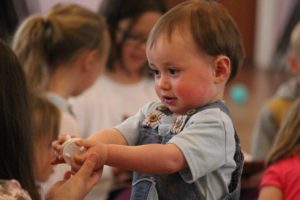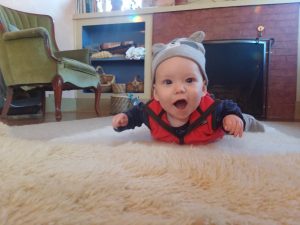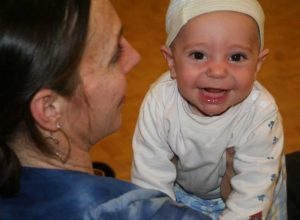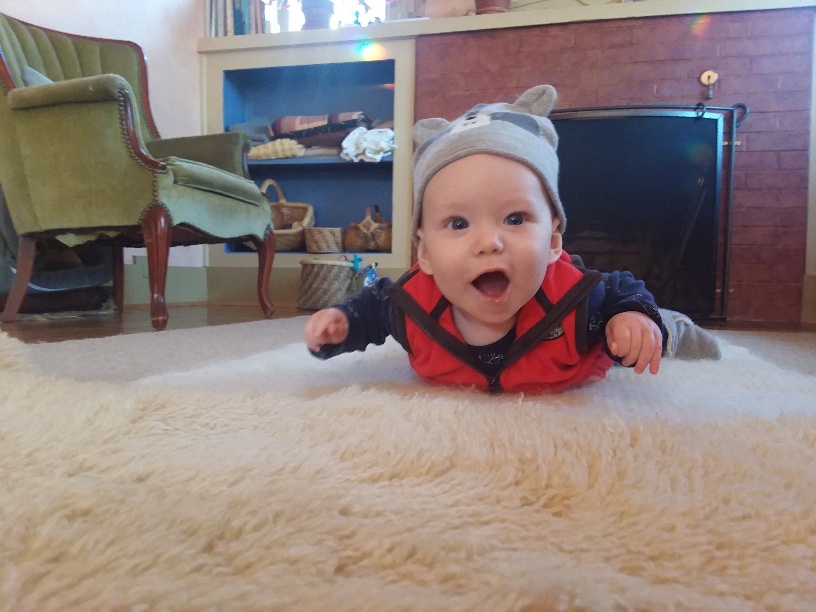Parents and caregivers of infants and toddlers who are guided by the insights of Rudolf Steiner have a wealth of practices in common, regardless of the setting. This is true whether it is called Waldorf, Steiner, LifeWays or by some other name altogether. It’s also helpful to recognize that Rudolf Steiner didn’t have a monopoly on insights or useful lenses for understanding young children–Pikler, Montessori, LeBoyer and others who closely observed infants and young children saw many of the same things, such as how open the child is to all sense impressions.
However, Steiner’s indications provide a comprehensive understanding of the young child that can transform the ways in which we are able to be with and nurture young children. The following are some of the characteristics of this approach:
- We recognize that children are “unique beings” whose development unfolds from within. Our task is to accompany young children in this process of “being who they are meant to be” by recognizing their unique gifts and struggles. Our primary task is to observe and encourage each child, recognizing that artificially hurrying development or skipping stages does not lead to healthy, balanced development. Thus we don’t need to “teach” young children to walk or talk but to provide freedom of movement and adults who are mindful of their own movements and speaking. However, through objective observation and understanding the wide range of child development, we can also provide guidance or referral for the small percentage of children with developmental difficulties.
- We study a developmental approach to human unfolding and recognize the ways in which children learn differently at different ages. By studying how consciousness, thinking, feeling and doing change as the child grows, we adapt our approach to the age and abilities of the individual child.

- We recognize that relationships are the most important part of each child’s environment–more important than any kind of “equipment.” Care that is relationship based forms the heart of all our programs from birth to three and throughout early childhood. Time is allowed for deep relationships to form between caregivers and children and among the children themselves, just as in a family. Caring for mixed-age groups of children is especially valuable for those reasons. Because connection is valued above “task,” activities of bodily care are used as times to connect with each child.
- Because relationships are so important, we recognize that the qualities and character of the adults matter. We do our best to model gratitude, reverence and joy around the children and to bring our best selves to them. We recognize that being a parent or childcare provider gives us countless opportunities for inner development and we cultivate practices that help us on this path. When we “fall off the tightrope” on one side or the other, we strive to do better while trying to have the same patience with ourselves that we want to have with the children.
- Because we know how deeply the young child is affected by the physical environment, we realize that “beauty matters” and is not just an add-on! For children who may be in childcare more hours than they are at home and awake, creating a beautiful home-like environment rather than an institutionalized one is especially important. As caregivers it can be valuable to ask ourselves, “Is this something I would want to have in my own home?”
Because the activities of a healthy home life provide a naturally nurturing context for young children’s development, we emphasize “taking life as the curriculum.” This can be at home with parents, grandparents or a nanny, or in a childcare setting. LifeWays especially supports parents to cultivate and value the activities involved in creating a home and encourages providers to create “home away from home” for young children, based on the recommendation from Rudolf Steiner:
“The task of the kindergarten [early childhood] teacher is to adapt the practical activities of daily life so that they are suitable for the child’s imitation through play….The activities of children in kindergarten [early childhood] must be derived directly from life itself rather than being ‘thought out’ by the intellectualized culture of adults. In the kindergarten, the most important thing is to give the children the opportunity to directly imitate life itself.” (From The Child’s Changing Consciousness by Rudolf Steiner)
While freedom of movement is important for the development of large-motor skills, spending most of the day on colored mats with plastic bottles and similar toys is time the infant or toddler is not experiencing “real life,” which can easily include ample opportunities for movement……
- The rhythmical experience of these life activities provides a health-giving foundation in which young children start to know how life unfolds. Repetition, reverence and ritual enable children to learn what to expect and enable them to relax about “what comes next.” They learn naturally and develop competency through repetition and the rhythmical unfolding of the day’s activities, not through the teacher providing verbal commentary on each event.
- Children are very sensitive to the differences between natural and synthetic materials. Because they feel the difference when wearing clothing made from natural fibers that can “breathe” even more acutely than most adults do, we use fabrics and toys made from natural materials whenever possible.
We recognize that imagination and creativity are the birthright of all children. To nurture this natural wellspring of creativity, we provide ample time and opportunities for self-directed play. Imaginative play encourages physical, social and emotional development and forms a sensory-rich foundation for later academic learning. We use simple toys that invite the child to “finish” them with their imagination.

- Because being outside provides countless benefits for healthy development, we spend time outdoors with the children every day possible, providing opportunities for both large-motor and imaginative play. Because actually being in nature is even more beneficial, we include this aspect as often as possible.
- Our programs involve no screen time because young children learn primarily through movement and need to be having direct experiences of the world, not virtual ones. In addition to taking time away from movement and self-directed play, screens with their pixilated and rapidly changing images are not good for young children’s developing brains or sense organs. We encourage parents to forgo apps, videos or recorded music with their children and to sing or play with them instead–recommendations supported by studies showing that only speech from a living person makes any difference in language development.
- Studies show that “orality” provides a strong basis for many skills including language development, listening, following directions, forming imaginative pictures, and reading. Therefore we provide a rich language program based in the spoken word, including nursery rhymes, singing, circle games, finger plays, and stories. “Formal instruction” and calling on the child’s memory are reserved for first grade, the time when brain imaging shows a “neural flowering.”
Interested in learning more? Rahima is offering her three-week online course Birth to Three – Child Development and Care beginning February 21st, 2024!

An online course for childcare providers, early childhood teachers and parents based on the insights of Rudolf Steiner, founder of Waldorf education.
Deepen your understanding of the unfolding experiences and needs of infants and toddlers through this unique online course developed and led by Rahima Baldwin Dancy.
